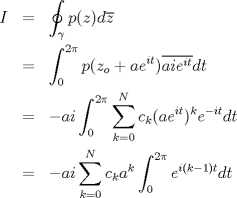|
|
|
|
|
|
|
  |
 Oct 28 2010, 09:56 PM Oct 28 2010, 09:56 PM
Publicado:
#1
|
|
 Dios Matemático Supremo Grupo: Usuario FMAT Mensajes: 929 Registrado: 22-June 08 Desde: Santiago Miembro Nº: 27.979 Nacionalidad:  Colegio/Liceo:  Universidad:  Sexo:  |
![TEX: \[\begin{gathered}<br /> \left. {\underline {\, <br /> {{\text{P1}}} \,}}\! \right| \hfill \\<br /> {\text{a) (2 ptos) Resuelva la ecuacion: }}{e^z} = \cos \left( {iz} \right) \hfill \\<br /> \hfill \\<br /> {\text{b) (2 ptos) Determine el conjunto A de todos los }}z \in \mathbb{C}{\text{ donde}} \hfill \\<br /> f\left( z \right) = z - i{\left| z \right|^2} + \Re e\left( z \right){\left( {\Im m\left( z \right)} \right)^2} \hfill \\<br /> \hfill \\<br /> {\text{c) (2 ptos) Determinar las funciones de variable real }}s\left( y \right),\;t\left( y \right),{\text{ diferenciables}} \hfill \\<br /> \left( {{\text{en }}\mathbb{R}} \right){\text{ tales que }}s\left( 0 \right) = 1,\;t\left( 0 \right) = 0{\text{ de modo que la funcion compleja}} \hfill \\<br /> f\left( {x + iy} \right) = {e^x}\left( {s\left( y \right) + it\left( y \right)} \right) \hfill \\<br /> {\text{sea holomorfa}}{\text{.}} \hfill \\<br /> {\text{Indicacion: Recordar que }}u''\left( r \right) + {a^2}u\left( r \right) = 0{\text{ tiene como solucion general}} \hfill \\<br /> u\left( r \right) = \alpha \sin \left( {ar} \right) + \beta \cos \left( {ar} \right). \hfill \\ <br />\end{gathered} \]<br />](./tex/29e4a3abec7c877806f905dabe5a8280.png) ![TEX: \[\begin{gathered}<br /> \left. {\underline {\, <br /> {{\text{P2}}} \,}}\! \right| \hfill \\<br /> {\text{a) (4 ptos) Sea }}p\left( z \right) = \sum\limits_{k = 0}^n {{c_k}{{\left( {z - {z_0}} \right)}^k}} {\text{ un polinomio de grado }}n{\text{ para }}{z_0} \in \mathbb{C}. \hfill \\<br /> {\text{Demuestre que se cumple}} \hfill \\<br /> \oint\limits_\gamma {p\left( z \right)d\bar z} = - 2\pi ip'\left( {{z_0}} \right){a^2} = - {a^2}\oint\limits_\gamma {\frac{{p'\left( z \right)}}<br />{{z - {z_0}}}dz} \hfill \\<br /> {\text{donde }}\gamma :\left| {z - {z_0}} \right| = a,{\text{ con }}a > 0. \hfill \\<br /> {\text{Nota: }}\oint\limits_\gamma {p\left( z \right)d\bar z} = \int\limits_c^d {f\left( {g\left( t \right)} \right)\overline {g'\left( t \right)} dt} ,{\text{ donde }}g:\left[ {c,d} \right] \to \mathbb{C}{\text{ es una parametrizacion de }}\gamma {\text{.}} \hfill \\<br /> {\text{Indicacion: Recuerde que }}{c_k} = \frac{{{p^{\left( k \right)}}\left( {{z_0}} \right)}}<br />{{k!}} \hfill \\<br /> \hfill \\<br /> {\text{b) (2 ptos) Calcule la integral}} \hfill \\<br /> \oint\limits_\gamma {\frac{{{z^2} + 1 - {e^z}}}<br />{{{z^2}{{\left( {z - 2} \right)}^2}}}dz} , \hfill \\<br /> {\text{donde }}\gamma {\text{ es la circunferencia }}\left| z \right| = a{\text{. Separe los casos }}0 < a < 2{\text{ y }}a > 2 \hfill \\ <br />\end{gathered} \]<br />](./tex/534b332efed7b39513eeb858562a0260.png) ![TEX: \[\begin{gathered}<br /> \left. {\underline {\, <br /> {{\text{P3}}} \,}}\! \right| \hfill \\<br /> {\text{a) (2 ptos) Determine los polos (con sus ordenes) y los correspondientes}} \hfill \\<br /> {\text{residuos de la funcion:}} \hfill \\<br /> f\left( z \right) = \frac{{1 - \cos \left( z \right)}}<br />{{{z^2}\sin \left( z \right)}} \hfill \\<br /> \hfill \\<br /> {\text{b) (2 ptos) Encuentre la serie de Taylor de la funcion}} \hfill \\<br /> f\left( z \right) = \frac{{z + 1}}<br />{{z\left( {z + 5} \right)}} \hfill \\<br /> {\text{en torno al punto }}{z_0} = i{\text{ y determine el radio de convergencia}}{\text{.}} \hfill \\<br /> {\text{Indicacion: Puede ser util usar una descomposicion en fracciones parciales}}{\text{.}} \hfill \\<br /> \hfill \\<br /> {\text{c) (2 ptos) Sea }}g{\text{ holomorfa en }}0{\text{ con }}g\left( 0 \right) \ne 0{\text{ y }}f\left( z \right) = \frac{{g\left( z \right)}}<br />{{{z^k}}},{\text{ con }}k \in \mathbb{N}\backslash \left\{ 0 \right\}. \hfill \\<br /> {\text{Pruebe que }}p = 0{\text{ es un polo de }}\frac{{f'\left( z \right)}}<br />{{f\left( z \right)}}.{\text{ Determine su orden y calcule su residuo}}{\text{.}} \hfill \\<br /> \hfill \\<br /> \left. {\underline {\, <br /> {{\text{Tiempo: 3 Horas}}} \,}}\! \right| \hfill \\ <br />\end{gathered} \]<br />](./tex/5f1a0b48fd15c2cb95973f25b1ce1f8c.png) --------------------  Ex-Electrico Usach 2008 Mechón Injenieria 2009 Tengo Sed. |
|
|
|
 Oct 30 2010, 07:37 AM Oct 30 2010, 07:37 AM
Publicado:
#2
|
|
|
Dios Matemático Supremo Grupo: Usuario FMAT Mensajes: 618 Registrado: 8-June 08 Desde: Paris Miembro Nº: 26.525 Nacionalidad:  Colegio/Liceo:  Universidad:  Sexo:  |
P2
a)  Notamos que si  , , por lo que  Además, como  con lo que se tiene la primera igualdad. La segunda igualdad es directa de la fórmula de Cauchy. -------------------- ¡Por más representación, vota Riesz!
|
|
|
|
 Oct 30 2010, 09:54 AM Oct 30 2010, 09:54 AM
Publicado:
#3
|
|
 Dios Matemático Supremo Grupo: Usuario FMAT Mensajes: 929 Registrado: 22-June 08 Desde: Santiago Miembro Nº: 27.979 Nacionalidad:  Colegio/Liceo:  Universidad:  Sexo:  |
P2 a)  Notamos que si  , , por lo que  Además, como  con lo que se tiene la primera igualdad. La segunda igualdad es directa de la fórmula de Cauchy. y para k=1? --------------------  Ex-Electrico Usach 2008 Mechón Injenieria 2009 Tengo Sed. |
|
|
|
 Oct 30 2010, 10:26 AM Oct 30 2010, 10:26 AM
Publicado:
#4
|
|
|
Dios Matemático Supremo Grupo: Usuario FMAT Mensajes: 9.897 Registrado: 6-April 08 Miembro Nº: 19.238 Nacionalidad:  Colegio/Liceo:  Sexo:  |
y para k=1? no seas fome po xd si ese es el caso trivial, integral definida de una cte dara 0. -------------------- |
|
|
|
 Oct 30 2010, 11:42 AM Oct 30 2010, 11:42 AM
Publicado:
#5
|
|
 Dios Matemático Supremo Grupo: Usuario FMAT Mensajes: 929 Registrado: 22-June 08 Desde: Santiago Miembro Nº: 27.979 Nacionalidad:  Colegio/Liceo:  Universidad:  Sexo:  |
Sorry, pero no se supone que eso mismo no daria cero? xD
PD: olvidenme xD Mensaje modificado por Crash! el Oct 30 2010, 12:38 PM --------------------  Ex-Electrico Usach 2008 Mechón Injenieria 2009 Tengo Sed. |
|
|
|
 Nov 3 2010, 07:41 PM Nov 3 2010, 07:41 PM
Publicado:
#6
|
|
 Maestro Matemático Grupo: Usuario FMAT Mensajes: 107 Registrado: 29-October 07 Desde: San Felipe-Santiago Miembro Nº: 11.941 Nacionalidad:  Universidad:  Sexo:  |
Hint :Para la 1 c)
se puede hacer de dos maneras: una es considerando Cauchy Riemann y la otra es utilizando el llamado principio de identidad. Salu2 Mensaje modificado por galois el Nov 7 2010, 06:26 PM |
|
|
|
 Nov 3 2010, 08:12 PM Nov 3 2010, 08:12 PM
Publicado:
#7
|
|
 Dios Matemático Supremo Grupo: Usuario FMAT Mensajes: 929 Registrado: 22-June 08 Desde: Santiago Miembro Nº: 27.979 Nacionalidad:  Colegio/Liceo:  Universidad:  Sexo:  |
2 parte c?
--------------------  Ex-Electrico Usach 2008 Mechón Injenieria 2009 Tengo Sed. |
|
|
|
 Nov 7 2010, 06:25 PM Nov 7 2010, 06:25 PM
Publicado:
#8
|
|
 Maestro Matemático Grupo: Usuario FMAT Mensajes: 107 Registrado: 29-October 07 Desde: San Felipe-Santiago Miembro Nº: 11.941 Nacionalidad:  Universidad:  Sexo:  |
|
|
|
|
 Nov 7 2010, 08:14 PM Nov 7 2010, 08:14 PM
Publicado:
#9
|
|
 Dios Matemático Supremo Grupo: Usuario FMAT Mensajes: 929 Registrado: 22-June 08 Desde: Santiago Miembro Nº: 27.979 Nacionalidad:  Colegio/Liceo:  Universidad:  Sexo:  |
bueno, como seria eso del principio de identidad? que yo lo hice por cauchy riemmann
--------------------  Ex-Electrico Usach 2008 Mechón Injenieria 2009 Tengo Sed. |
|
|
|
 Nov 9 2010, 06:52 PM Nov 9 2010, 06:52 PM
Publicado:
#10
|
|
 Maestro Matemático Grupo: Usuario FMAT Mensajes: 107 Registrado: 29-October 07 Desde: San Felipe-Santiago Miembro Nº: 11.941 Nacionalidad:  Universidad:  Sexo:  |
f,g : G---> C analíticas
f=g ssi { z en G tq f(z)=g(z)} tiene un punto de acumulación, en este caso la sucesión xn = 1/n te serviría para probar que la exponencial real, es la única función que cumple ciertas cosas a partir de las condiciones que tienes. Salu2 |
|
|
|
  |
1 usuario(s) está(n) leyendo esta discusión (1 invitado(s) y 0 usuario(s) anónimo(s))
0 miembro(s):
| Versión Lo-Fi | Fecha y Hora actual: 8th July 2025 - 02:38 AM |











